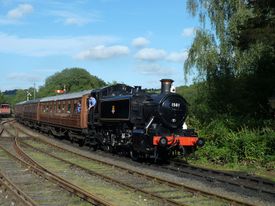GWR Pannier 1501
Contents
1501 in service
British Railways
1501 entered service on 31 July 1949[1] at London’s Old Oak Common, where duties included hauling long rakes of empty coaching stock in and out of Paddington Station. On 30 November 1950[1] the locomotive was reallocated to Southall for local shunting duties.
The BR modernisation programme led to a swift replacement of the 1500 class by 350hp diesel shunters, and 1501 was withdrawn from service at Southall by BR in January 1961[1] after a working life of just 11 years 5 months. Following withdrawal, 1501 was moved to Swindon. Two other class members, 1502 and 1509, were also moved to Swindon after withdrawal from Didcot and Newport respectively, and in February 1961 all three were sold to the National Coal Board.[2]
National Coal Board
In June 1961 all three locomotives were towed by rail via Bagnalls at Stafford to the Andrew Barclay works at Kilmarnock for repairs and a repaint into unlined maroon livery. Later in the year they returned by road to the colliery at Keresley, Coventry where, still carrying their BR numbers, they worked in the NCB sidings and on the two mile branch line to the Coventry to Nuneaton line at Three Spires Junction. 1969 saw the locomotives once again replaced by diesel shunters, with 1501 the last of the three in use until September of that year.[2]
1501 in preservation
All three locomotives were inspected during 1969 and reserved by members of the Warwickshire Railway Society and SVR. After this inspection and consultation with NCB staff, 1501 was selected for preservation on the SVR and an appeal for funds appeared in the Autumn 1969 edition of SVR News.[3] The other two were used as a source of parts for restoring 1501 and other ex-GWR locomotives lacking fittings at Barry following vandalism, after which the remains were sold for scrap and cut up at Cashmores, Great Bridge in October 1970.[2]
1501 was initially towed by rail from Coventry to Tyseley in July 1970 for wheel turning, before a further move behind a diesel to Bewdley on 17 October 1970. During the latter move, excessive speed caused damage to one of 1501’s axle boxes.
A lengthy restoration was undertaken, initially at Bridgnorth but mainly at Bewdley, largely through the endeavours of the 15xx Pannier Tank Fund with financial assistance from the Warwickshire Railway Society. Following this restoration, 1501 was first steamed on 29 May 1997.[2] Over the next 10 years the locomotive was re-tyred but otherwise served a full ‘ticket’ before being taken out of service at the end of 2006. 1501 then became one of the first group of locomotives to be displayed in the Engine House from opening in March 2008.[4]
During 2009, plans for an overhaul of 75069 were delayed after a review of the boiler revealed that significant work would be required.[5] 1501 was seen as a potential quick turnaround,[6] and the locomotive left the Engine House in October 2009[7] to begin an overhaul. 1501 was steamed again on 15 August 2012, re-entering service in BR lined black livery which, although not normally appropriate for shunting engines, was carried by 1503 and 1505 while at Old Oak Common.[8]
In service on the SVR, 1501 has proved a powerful locomotive for its size, acquiring the nickname “the raging bull”. The locomotive is owned by the 1501 Pannier Tank Association.
Trivia
As noted above, 1501 is a member of the GWR 1500 class, also referred to as the 15xx Class. 108 0-6-0T tank engines of the 645 Class were built at the GWR’s Wolverhampton works between 1872 and 1881. The last 72 of these featured a revised design; the first of which was numbered 1501. This modified sub-class is therefore sometimes referred to as the “1501 Class”.[9]
See also
References
Links
GWR 1500 Class on Wikipedia
1501 on BRDatabase.Info
1501 Pannier Tank Association website
| ||||||||||||||||||||||||||||||||||||||||||||||||||||||||

